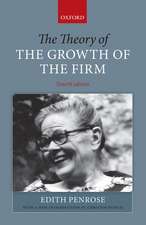Innovation Interactions Between Knowledge-Intensive Business Services And Small And Medium-Sized Enterprises: An Analysis in Terms of Evolution, Knowledge and Territories: Technology, Innovation and Policy (ISI), cartea 11
Autor Emmanuel Mulleren Limba Engleză Paperback – 26 ian 2001
Preț: 383.71 lei
Nou
Puncte Express: 576
Preț estimativ în valută:
73.42€ • 76.86$ • 60.75£
73.42€ • 76.86$ • 60.75£
Carte tipărită la comandă
Livrare economică 07-21 aprilie
Preluare comenzi: 021 569.72.76
Specificații
ISBN-13: 9783790813623
ISBN-10: 3790813621
Pagini: 220
Ilustrații: XVII, 198 p. 94 illus.
Dimensiuni: 155 x 235 x 12 mm
Greutate: 0.31 kg
Ediția:Softcover reprint of the original 1st ed. 2001
Editura: Physica-Verlag HD
Colecția Physica
Seria Technology, Innovation and Policy (ISI)
Locul publicării:Heidelberg, Germany
ISBN-10: 3790813621
Pagini: 220
Ilustrații: XVII, 198 p. 94 illus.
Dimensiuni: 155 x 235 x 12 mm
Greutate: 0.31 kg
Ediția:Softcover reprint of the original 1st ed. 2001
Editura: Physica-Verlag HD
Colecția Physica
Seria Technology, Innovation and Policy (ISI)
Locul publicării:Heidelberg, Germany
Public țintă
ResearchCuprins
General introduction.- 1: Innovation as the expression of firms’ evolution capacity.- 1.1 Innovation as an evolutionary process.- 1.2 Innovation as a knowledge-based process.- 1.3 Nature and forms of innovation: towards a continuum approach.- Conclusion.- 2: Interactions between KIES and SMES and impact on innovation capacities.- 2.1 Interactions: between market and hierarchy?.- 2.2 The impact of interactions with KIES on SMEs.- 2.3 KIBS innovation capacity and the influence of interactions with SMEs.- Conclusion.- 3: Territorial determinants and evolution capacities of SMEs and KIBS.- 3.1 Proximity and innovation.- 3.2 Territory and innovation.- 3.3 The impact of territorial determinants on SMEs and KIRS interactions and evolution.- Conclusion.- 4: Operationalisation of the analysis.- 4.1 From the hypotheses to the key variables.- 4.2 Structure of the data.- 4.3 The statistical exploitation procedure.- Conclusion.- 5: Statistical exploitation of the SME sample.- 5.1 Segmentation procedures.- 5.2 Multiple correspondence analysis.- 5.3 Path modelling.- Conclusion.- 6: Statistical exploitation of the KIBS sample.- 6.1 Segmentation procedures.- 6.2 Multiple correspondence analysis.- 6.3 Path modelling.- Conclusion.- 7: Main findings and policy implications.- 7.1 Interpretation of the key fmdings.- 7.2 Towards an integrated typology of innovation interactions.- 7.3 Implications for policies.- Conclusion.- General conclusion.- References.- Appendix A: Basic frequencies of the selected variables.- Appendix B: Selected bivariate tests.- Appendix C: PROBIT analysis.
Caracteristici
Includes supplementary material: sn.pub/extras

























